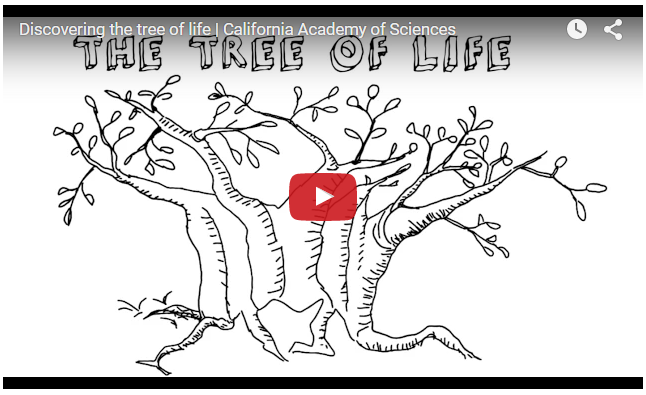Tree of Life: Difference between revisions
Siterunner (talk | contribs) No edit summary |
Siterunner (talk | contribs) No edit summary |
||
| Line 9: | Line 9: | ||
http://www.pnas.org/content/early/2015/09/16/1423041112 | http://www.pnas.org/content/early/2015/09/16/1423041112 | ||
'' | ''Authors of the Study'' | ||
''Scientists have used gene sequences and morphological data to construct tens of thousands of evolutionary trees that describe the evolutionary history of animals, plants, and microbes. This study is the first, to our knowledge, to apply an efficient and automated process for assembling published trees into a complete tree of life. This tree and the underlying data are available to browse and download from the Internet, facilitating subsequent analyses that require evolutionary trees. The tree can be easily updated with newly published data. Our analysis of coverage not only reveals gaps in sampling and naming biodiversity but also further demonstrates that most published phylogenies are not available in digital formats that can be summarized into a tree of life.'' | ''Scientists have used gene sequences and morphological data to construct tens of thousands of evolutionary trees that describe the evolutionary history of animals, plants, and microbes. '''This study is the first, to our knowledge, to apply an efficient and automated process for assembling published trees into a complete tree of life. This tree and the underlying data are available to browse and download from the Internet, facilitating subsequent analyses that require evolutionary trees. The tree can be easily updated with newly published data.''' Our analysis of coverage not only reveals gaps in sampling and naming biodiversity but also further demonstrates that most published phylogenies are not available in digital formats that can be summarized into a tree of life.'' | ||
http://www.pnas.org/content/early/2015/09/16/1423041112.full.pdf | http://www.pnas.org/content/early/2015/09/16/1423041112.full.pdf | ||
Revision as of 20:28, 20 September 2015
An open source 'Tree of life' that includes all the species known to humans to date
U.S. National Science Foundation / September 2015
First draft of ‘Tree of Life’ including 2.3 million species released
http://www.eurekalert.org/pub_releases/2015-09/uom-ol091815.php
http://www.pnas.org/content/early/2015/09/16/1423041112
Authors of the Study
Scientists have used gene sequences and morphological data to construct tens of thousands of evolutionary trees that describe the evolutionary history of animals, plants, and microbes. This study is the first, to our knowledge, to apply an efficient and automated process for assembling published trees into a complete tree of life. This tree and the underlying data are available to browse and download from the Internet, facilitating subsequent analyses that require evolutionary trees. The tree can be easily updated with newly published data. Our analysis of coverage not only reveals gaps in sampling and naming biodiversity but also further demonstrates that most published phylogenies are not available in digital formats that can be summarized into a tree of life.
http://www.pnas.org/content/early/2015/09/16/1423041112.full.pdf
The realization that all organisms on Earth are related by common descent was one of the most profound insights in scientific history. The goal of reconstructing the tree of life is one of the most daunting challenges in biology. The scope of the problem is immense... most species have yet to be described. Despite decades of effort and thousands of phylogenetic studies on diverse clades, we lack a comprehensive tree of life, or even a summary of our current knowledge. One reason for this shortcoming is lack of data. GenBank contains DNA sequences for 411,000 species, only 22% of estimated named species. Although some gene regions have been widely sequenced across some lineages, they are insufficient for resolving relationships across the entire tree. Most recognized species have never been included in a phylogenetic analysis because no appropriate molecular or morphological data have been collected...
○ ○ ○ ○ ○ ○ ○ ○ ○ ○ ○ ○ ○ ○ ○ ○ ○ ○ ○ ○ ○ ○ ○ ○ ○ ○ ○ ○ ○ ○ ○ ○ ○
Treemachine
at GitHub / OpenTreeofLife -- https://github.com/OpenTreeOfLife/treemachine
Scientists have used gene sequences and morphological data to construct tens of thousands of evolutionary trees that describe the evolutionary history of animals, plants, and microbes.
Principal investigator Karen Cranston of Duke University said, “This is the first real attempt to connect the dots and put it all together. Think of it as Version 1.0”...
#OpenAccess - https://twitter.com/hashtag/openaccess?src=hash
○ ○ ○ ○ ○ ○ ○ ○ ○ ○ ○ ○ ○ ○ ○ ○ ○ ○ ○ ○ ○ ○ ○ ○ ○ ○ ○ ○ ○ ○ ○ ○
